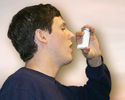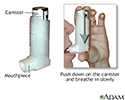How to use an inhaler - no spacer
Metered-dose inhaler (MDI) administration - no spacer; Bronchial nebulizer; Wheezing - nebulizer; Reactive airway - nebulizer; COPD - nebulizer; Chronic bronchitis - nebulizer; Emphysema - nebulizer
Using a metered-dose inhaler (MDI) seems simple. But many people do not use them the right way. If you use your MDI the wrong way, less medicine gets to your lungs and most remains in the back of your mouth. If you have a spacer, use it. It helps get more medicine into your airways.
( The instructions below are not for dry powder inhalers. They have different instructions .)
Getting Ready
- Take off the cap and shake the inhaler hard.
- If you have not used the inhaler in a while, you may need to prime it. See the instructions that came with your inhaler for how to do this.
- Breathe out all the way.
- Hold the inhaler 1 to 2 inches (2.5 to 5 centimeters) in front of your mouth (about the width of 2 fingers).
Breathe in Slowly
- Start breathing in slowly through your mouth, then press down on the inhaler 1 time.
- Keep breathing in slowly, as deeply as you can.
Hold Your Breath
- If you can, hold your breath as you slowly count to 10. This lets the medicine reach deep into your lungs.
- If you are using inhaled, quick-relief medicine (beta-agonists), wait about 1 minute before you take your next puff. You do not need to wait a minute between puffs for other medicines.
- After using your inhaler, rinse your mouth with water, gargle, and spit. This helps reduce side effects from your medicine.
Keep Your Inhaler Clean
Look at the hole where the medicine sprays out of your inhaler. If you see powder in or around the hole, clean your inhaler.
- Remove the metal canister from the L-shaped plastic mouthpiece.
- Rinse only the mouthpiece and cap in warm water.
- Let them air dry overnight.
- In the morning, put the canister back inside. Put the cap on.
- DO NOT rinse any other parts.
Replacing Your Inhaler
Most inhalers come with counters on the canister. Keep an eye on the counter and replace the inhaler before you run out of medicine.
DO NOT put your canister in water to see if it is empty. This does not work.
Bring your inhaler to your clinic appointments. Your doctor can make sure you are using it the right way.
Storing Your Inhaler
Store your inhaler at room temperature. It may not work well if it is too cold. The medicine in the canister is under pressure. So make sure you do not get it too hot or puncture it.
References
Laube BL, Dolovich MB. Aerosols and aerosol drug delivery systems. In: Adkinson NF Jr, Bochner BS, Burks AW, et al, eds. Middleton's Allergy Principles and Practice . 8th ed. Philadelphia, PA: Elsevier Saunders; 2014:chap 66.
National Heart, Lung, and Blood Institute. National Asthma Education and Prevention Program. How to use a metered-dose inhaler. Last revised March 2013. www.nhlbi.nih.gov/health/public/lung/asthma/asthma_tipsheets.pdf . Accessed April 11, 2016.
-
How to use an asthma inhaler
Animation
-
Inhaler medication administration - illustration
An inhaler is a quick way of administering medicine directly into the bronchial passageways to promote clearer breathing.
Inhaler medication administration
illustration
Review Date: 2/15/2016
Reviewed By: Neil K. Kaneshiro, MD, MHA, Clinical Assistant Professor of Pediatrics, University of Washington School of Medicine, Seattle, WA. Also reviewed by David Zieve, MD, MHA, Isla Ogilvie, PhD, and the A.D.A.M. Editorial team.


